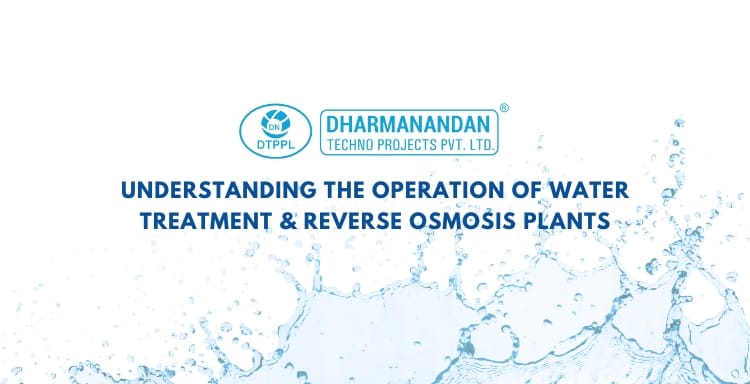
Table of Contents
Understanding the Operation of Water Treatment & Reverse Osmosis Plants
February 18, 2025
The increasing demand for clean, safe, and high-quality packaged drinking water has led to advanced purification processes that ensure every drop meets rigorous safety and purity standards. A RO plant, whether it is a commercial RO plant or an industrial RO plant, is at the heart of this transformation, employing multiple filtration and treatment stages to remove contaminants, improve taste, and maintain mineral balance. This article explores the intricate technical process behind RO water plant operations, highlighting its role in producing superior quality water for consumers.
Preliminary Treatment: The First Line of Defense in RO Water Treatment
Before water encounters the sophisticated RO membranes, a comprehensive preliminary treatment phase is essential. This stage acts as the crucial first line of defense, removing larger particles, sediment, chlorine, and various contaminants that can compromise the RO system’s performance and longevity.
Raw Water Intake and Screening
The water source, whether municipal, borewell, or surface water, determines the specific pre-treatment processes required. A thorough assessment of turbidity, total dissolved solids (TDS), pH levels, and microbial content dictates the necessary filtration methods.
- Source Water Characterization: Testing for turbidity, total suspended solids (TSS), alkalinity, organic matter, and contaminants like iron, manganese, and arsenic ensures the appropriate treatment methods are applied.
- Intake Design: Coarse screens, bar racks, or traveling screens minimize debris entry.
- Pre-Sedimentation (Optional): Surface water with high turbidity may undergo pre-sedimentation for particle removal.
- Pre-chlorination (Optional): In select cases, chlorine is added to manage biological growth in pipelines and downstream equipment.
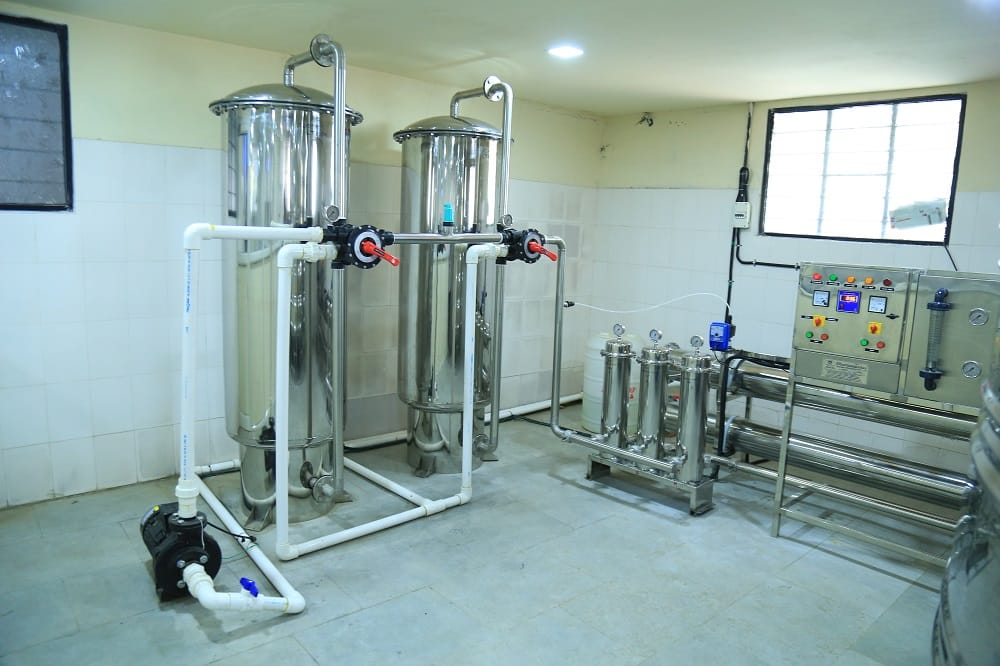
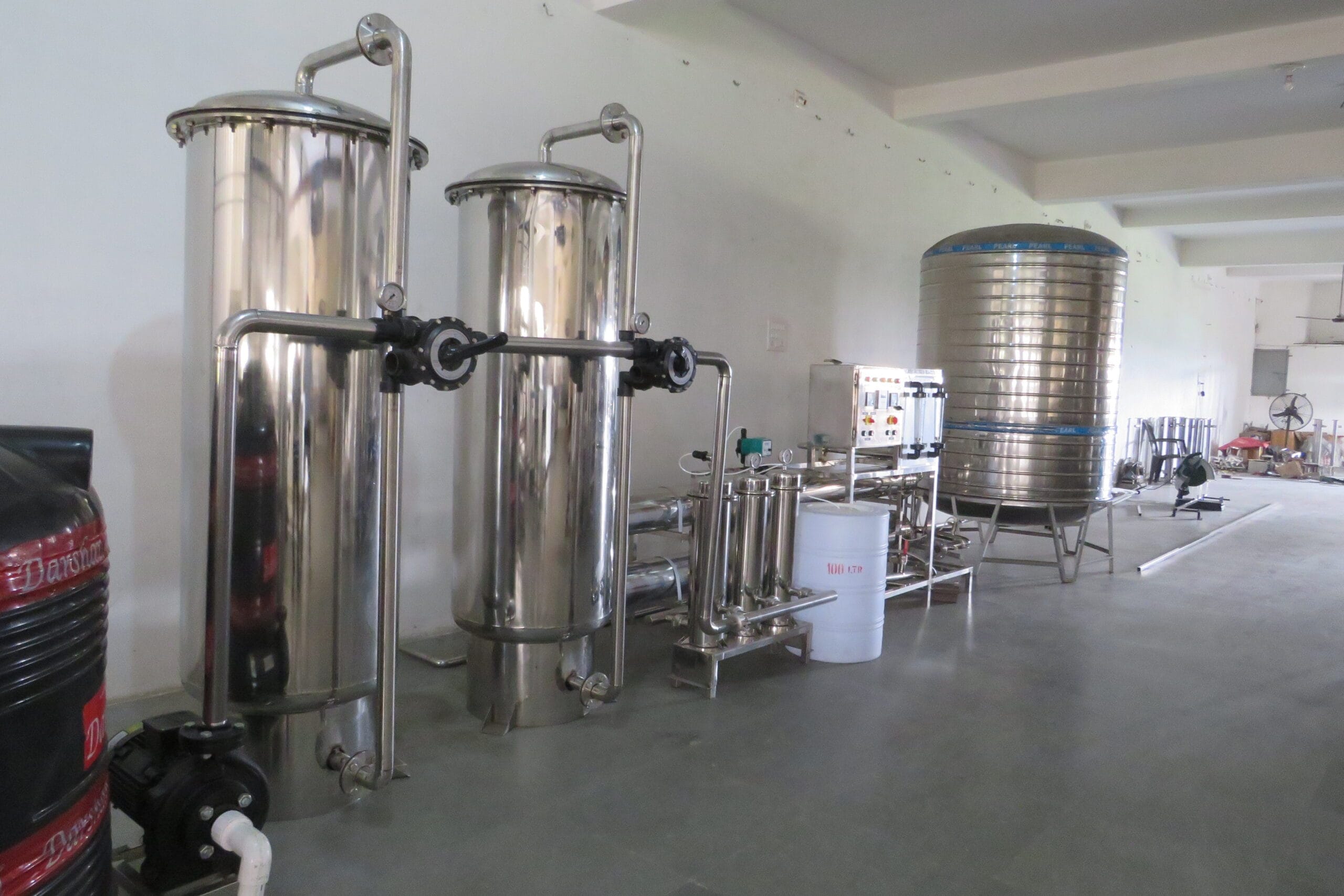
Sediment Filtration: Multi-Layered Approach
Water passes through multiple filtration layers to eliminate suspended particles before reaching the water treatment plant components.
- Sand Filtration: Graded sand layers capture particles through depth filtration.
- Multimedia Filtration: Anthracite, sand, and garnet improve filtration efficiency by removing a wider range of particle sizes.
- Cartridge Filtration: Replaceable cartridges with specific micron ratings provide precision filtration.
Activated Carbon Filtration: Improving Taste and Odor
A crucial step in Industrial RO Plant, activated carbon removes chlorine, organic compounds, and contaminants affecting taste and color.
- Activated Carbon Selection: Coconut shell-based granulated activated carbon (GAC) is preferred for its high adsorption capacity.
- Contact Time: Optimized to ensure maximum contaminant removal.
- Backwashing and Regeneration: Periodic backwashing maintains filtration efficiency, with some systems supporting thermal or chemical regeneration.
Water Softening (Optional)
In regions with hard water, a water softener is necessary to prevent scaling in Mineral Water Treatment Plant operations.
- Resin Selection: Strong acid cation exchange resins are used based on water hardness.
- Regeneration Optimization: Controlled brine concentration ensures effective hardness removal.
- Hardness Leakage Monitoring: Regular monitoring prevents breakthrough and maintains consistent performance.
Reverse Osmosis (RO): The Heart of Purification
RO technology drives purification, eliminating dissolved salts, minerals, and other impurities in Water Treatment Plant Manufacturers setups.
Technical Principles
- Osmotic Pressure: The external pressure applied must exceed the osmotic pressure for effective purification.
- Membrane Structure: Thin-film composite (TFC) membranes selectively allow water molecules to pass.
- Concentration Polarization: Proper system design and crossflow velocities prevent performance degradation.
Operational Parameters
- Salt Rejection Rate: Up to 99% removal of dissolved salts in an Industrial RO System.
- Permeability and Flux: Influenced by pressure, temperature, and feed water quality.
- Temperature Sensitivity: Membrane performance varies with temperature, requiring careful monitoring.
- pH Tolerance: TFC membranes have an optimal pH operating range to avoid degradation.
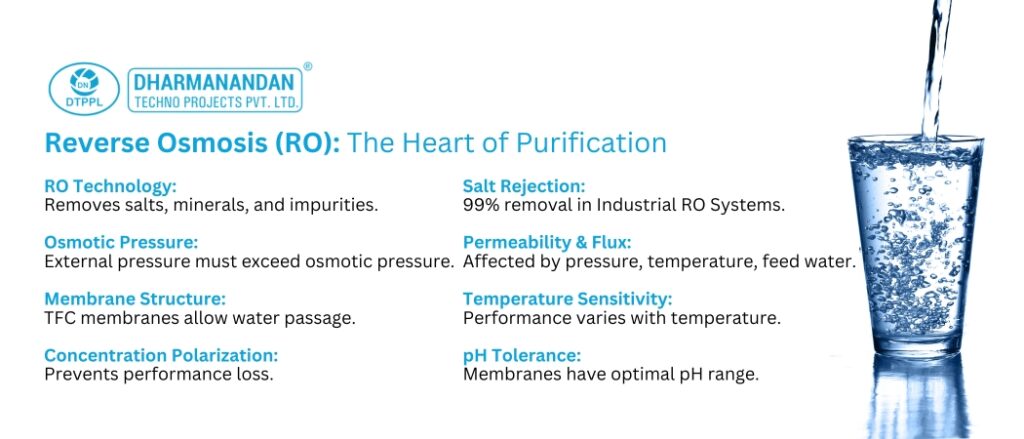
Reverse Osmosis (RO) Stage: Core of Water Purification
The heart of the RO process is the semi-permeable membrane, which effectively separates water molecules from larger molecules like salts, minerals, bacteria, and viruses.
High-Pressure Pump:
The high-pressure pump forces the pre-treated water through the semi-permeable membrane, applying pressure greater than the natural osmotic pressure. This step is crucial for efficient filtration.
Semi-Permeable Membrane:
The pressurized water passes through the RO membrane, which contains tiny pores. Only water molecules can pass through, leaving behind contaminants such as dissolved salts, minerals, bacteria, and viruses.
Permeate and Concentrate:
The purified water that passes through the membrane is called permeate. The remaining water, which contains rejected impurities, is known as concentrate or brine, which is typically flushed away or reprocessed in larger systems.
Reverse Osmosis Post-Treatment: Polishing and Perfecting the Product
Final processing ensures the RO permeate meets stringent quality standards before distribution.
UV Sterilization: Microbial Inactivation
- UV Wavelength: Germicidal effectiveness peaks at 254 nm, targeting microbial DNA.
- Reactor Design: Optimized for uniform exposure to ensure effective sterilization.
Ozonation: Oxidation and Disinfection
Ozone enhances microbial control in Mineral Water Treatment Plant Supplier systems.
- Ozone Generation: Produced using corona discharge or UV light, then injected for oxidation.
- Decomposition Kinetics: Ensures minimal residual ozone before packaging.
Mineralization: Restoring Essential Minerals
For mineral water, controlled mineral addition in Mineral Water Treatment Plant Exporter processes enhances taste and health benefits.
- Mineral Selection: Food-grade mineral salts ensure purity and precise formulation.
- Mixing Mechanisms: Uniform distribution is achieved using static mixers or in-tank agitation.
pH Adjustment: Stability and Taste Optimization
- Buffering Capacity: Influenced by alkalinity, impacting how acids or bases affect pH.
- Chemical Selection: Sodium hydroxide or carbon dioxide is commonly used for pH regulation.
- Taste and Corrosion Control: Optimized for ideal drinking water balance.
Post-treatment: Finalizing the Purified Water
Once the water passes through the RO membrane, it may undergo additional post-treatment processes to ensure it is clean and safe for consumption.
Storage Tank:
The purified water (permeate) is collected and stored in a tank for later use. This storage process ensures that clean water is available on demand.
Post-filtration:
A polishing filtration stage may follow, where the water passes through an additional filter to further remove any remaining contaminants, ensuring the water is of the highest quality.
Re-mineralization (Optional):
In some systems, minerals such as calcium and magnesium may be added back to the water after the RO process to enhance taste and provide health benefits.
Regulatory Approvals for Water Treatment Plant Certification
For businesses entering the water treatment plant business, compliance with regulatory frameworks is crucial.
- FSSAI License: Ensures safety and quality adherence.
- BIS Certification: Mandates industry-specific purity and production standards.
- Environmental Clearance: Required for groundwater extraction and sustainable operations.
Cost Considerations in Water Treatment Plant Parts
When setting up a Water Treatment Device, costs vary based on equipment, maintenance, and operational expenses.
- Equipment Costs: Filtration units, RO membranes, pumps, and monitoring systems.
- Operational Costs: Power consumption, consumables, and maintenance frequency.
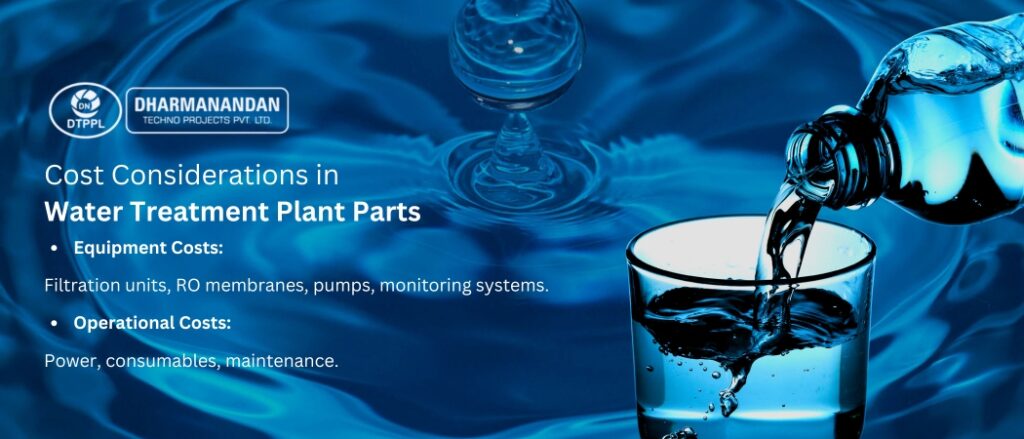
Business Prospects and Profitability
A well-structured Water Treatment Plant Business can be highly profitable given increasing demand.
- Water Plant Business Profit: Efficiency and operational scale drive profitability.
- Mineral Water Business Profit: Branding and mineral composition customization provide competitive advantages.
- Water Bottle Business Profit: Scalability and distribution networks influence financial success.

Factors Affecting RO Plant Performance
The efficiency of an RO plant is determined by several factors:
Feed Water Quality:
The level of impurities in the source water affects the required pre-treatment stages and the overall efficiency of the RO plant. The higher the contamination, the more extensive the pre-treatment processes needed.
Temperature:
Water temperature plays a role in RO performance. Higher temperatures typically increase the water production rate, while lower temperatures can decrease efficiency and performance.
Pressure:
The applied pressure must be sufficient to overcome osmotic pressure and force water through the semi-permeable membrane. The ideal pressure ensures effective filtration and optimal water recovery.
Recovery Rate:
This refers to the amount of purified water produced in relation to the feed water used. Optimizing the recovery rate involves balancing the volume of output with the need to prevent membrane fouling.
Conclusion: The Science Behind Every Drop
The journey from raw water to high-quality packaged drinking water underscores the precision of Water Treatment Plant Manufacturers. Each stage—pre-treatment, RO purification, and post-treatment—plays a crucial role in achieving purity, safety, and consumer satisfaction. With continuous advancements, water treatment technology is evolving toward greater efficiency and sustainability. Collaborating with an experienced industrial RO plant manufacturer like Dharmanandan Techno Projects Private Limited (DTPPL) can help businesses establish a well-planned and efficient operation.

Director – Global Marketing and Sales
Mr. Bhavesh from Dharmanandan Techno Projects Pvt. Ltd. has played a pivotal role in elevating the DTPPL brand to the global stage, leveraging his exceptional expertise in marketing and communications. He is committed to helping clients achieve significant growth while strengthening their own brands. Dharmanandan Techno Projects Pvt. Ltd. is a leading manufacturer and supplier of water purification systems and turnkey solutions for mineral water plants. With years of experience in designing and delivering high-quality water treatment solutions, the company provides end-to-end services, including system design, installation, maintenance, and ongoing support. Specializing in scalable and customizable water plants, DTPPL has successfully served industries worldwide, ensuring clean and safe drinking water across diverse applications.
